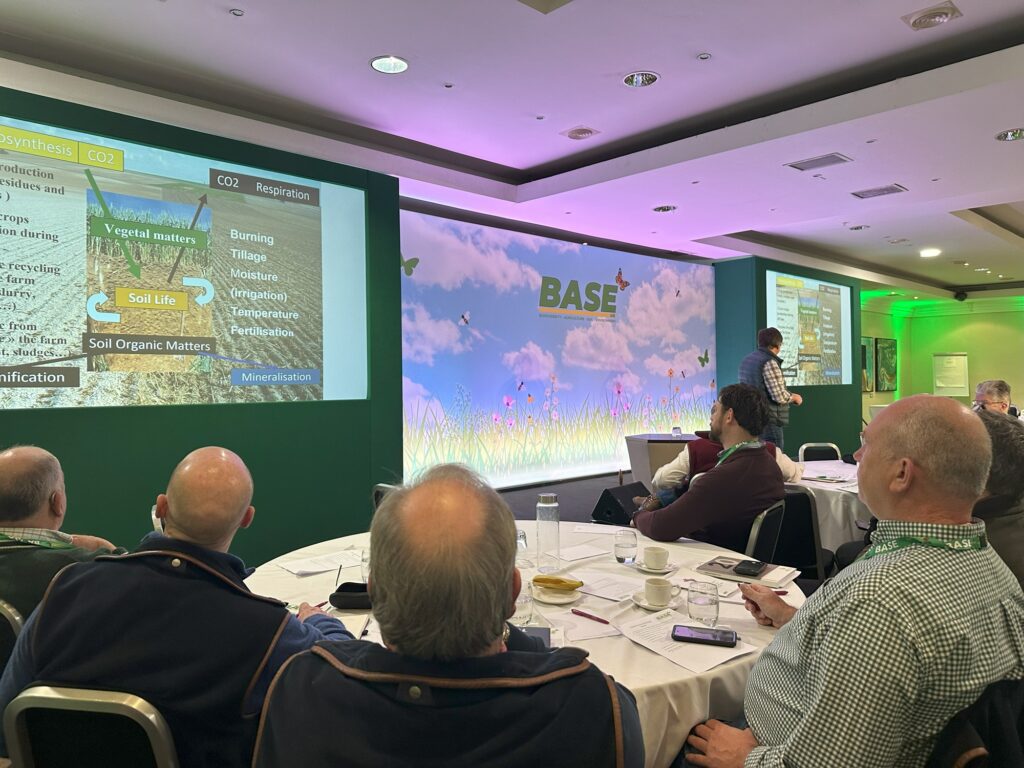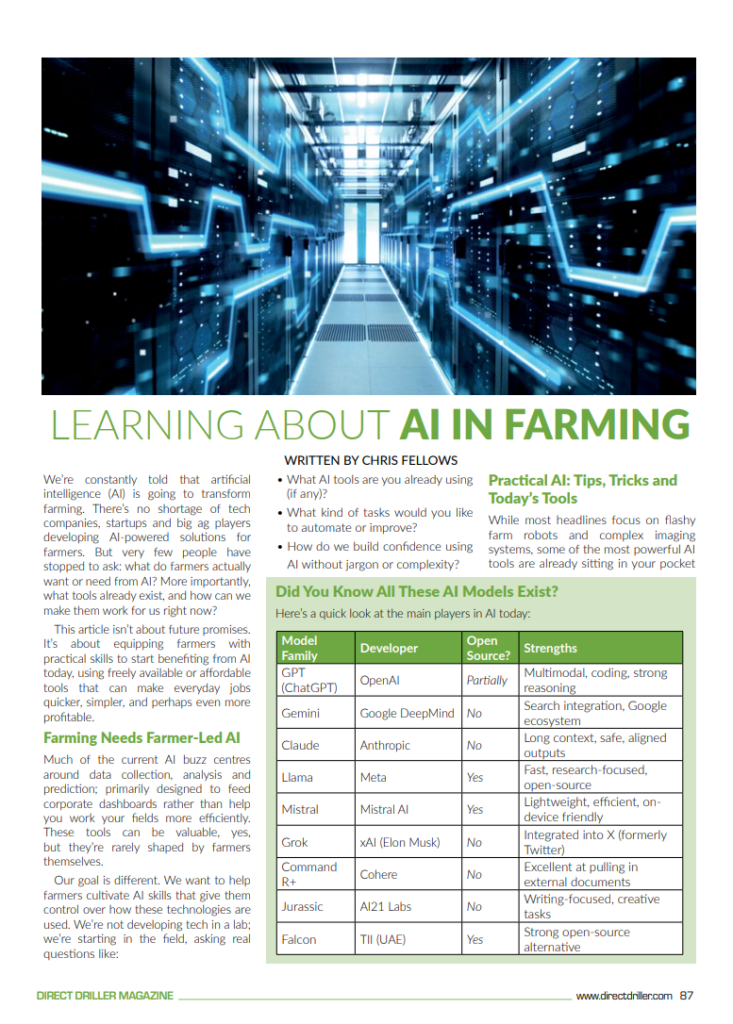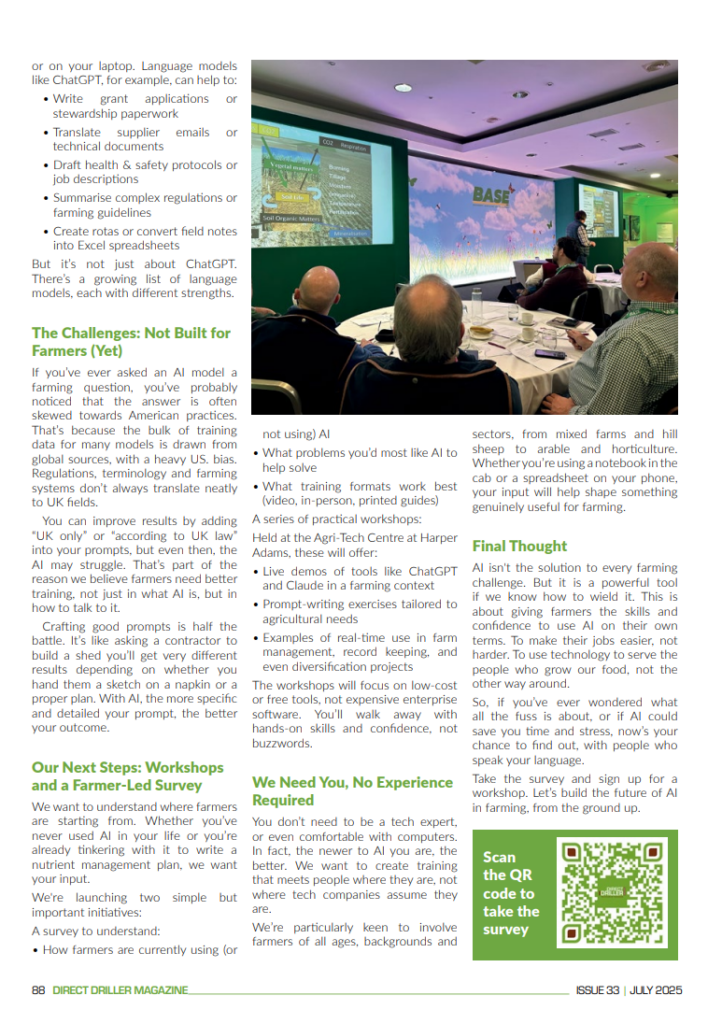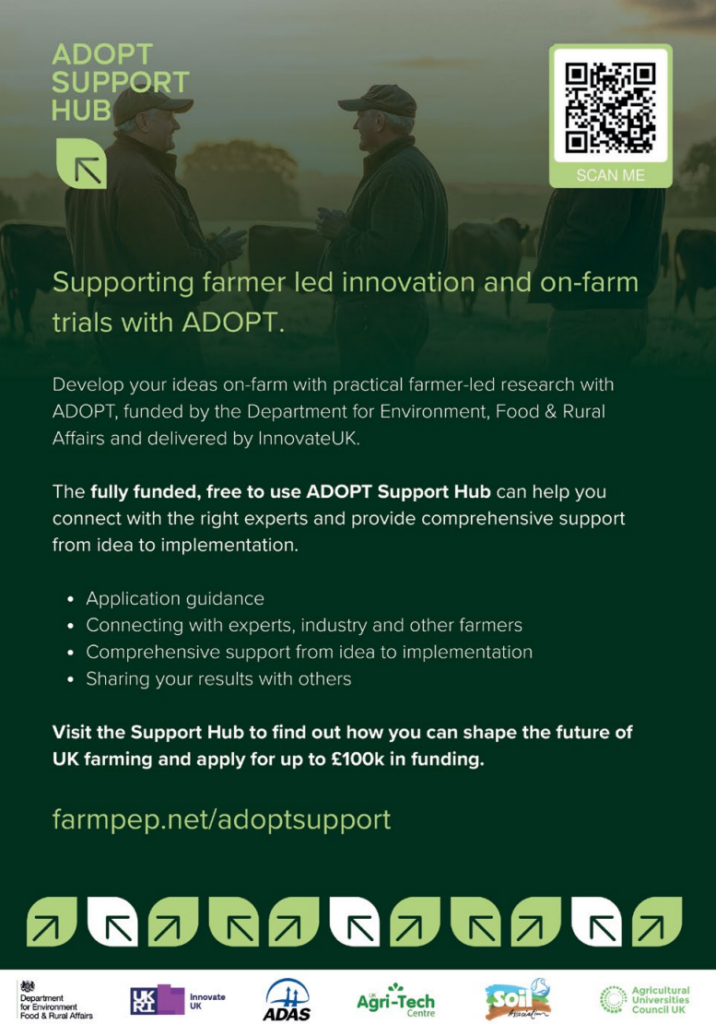We’re constantly told that artificial intelligence (AI) is going to transform farming. There’s no shortage of tech companies, startups, and big ag players developing AI-powered solutions for farmers. But very few people have stopped to ask: what do farmers actually want or need from AI? More importantly, what tools already exist, and how can we make them work for us right now?
This article isn’t about future promises. It’s about equipping farmers with practical skills to start benefiting from AI today, using freely available or affordable tools that can make everyday jobs quicker, simpler, and perhaps even more profitable.
Farming Needs Farmer-Led AI
Much of the current AI buzz centres around data collection, analysis, and prediction, primarily designed to feed corporate dashboards rather than help you walk your fields more efficiently. These tools can be valuable, yes, but they’re rarely shaped by farmers themselves.
Our goal is different. We want to help farmers cultivate AI skills that give them control over how these technologies are used. We’re not developing tech in a lab; we’re starting in the field, asking real questions like:
- What AI tools are you already using (if any)?
- What kind of tasks would you like to automate or improve?
- How do we build confidence using AI without jargon or complexity?
Practical AI: Tips, Tricks, and Today’s Tools
While most headlines focus on flashy farm robots and complex imaging systems, some of the most powerful AI tools are already sitting in your pocket or on your laptop. Language models like ChatGPT, for example, can help:
- Write grant applications or stewardship paperwork
- Translate supplier emails or technical documents
- Draft health & safety protocols or job descriptions
- Summarise complex regulations or farming guidelines
- Create rotas or convert field notes into Excel spreadsheets
But it’s not just about ChatGPT. There’s a growing list of language models, each with different strengths.
Did You Know All These AI Models Exist?
Here’s a quick look at the main players in AI today:
| Model Family | Developer | Open Source? | Strengths |
| GPT (ChatGPT) | OpenAI | Partially | Multimodal, coding, strong reasoning |
| Gemini | Google DeepMind | No | Search integration, Google ecosystem |
| Claude | Anthropic | No | Long context, safe, aligned outputs |
| LLaMA | Meta | Yes | Fast, research-focused, open-source |
| Mistral | Mistral AI | Yes | Lightweight, efficient, on-device friendly |
| Grok | xAI (Elon Musk) | No | Integrated into X (formerly Twitter) |
| Command R+ | Cohere | No | Excellent at pulling in external documents |
| Jurassic | AI21 Labs | No | Writing-focused, creative tasks |
| Falcon | TII (UAE) | Yes | Strong open-source alternative |
While most farmers will likely use GPT or Gemini for now, other models may better suit specific needs, especially when integrated into apps or farm software.
The Challenges: Not Built for Farmers (Yet)
If you’ve ever asked an AI model a farming question, you’ve probably noticed that the answer is often skewed towards American practices. That’s because the bulk of training data for many models is drawn from global sources, with a heavy U.S. bias. Regulations, terminology, and farming systems don’t always translate neatly to UK fields.
You can improve results by adding “UK only” or “according to UK law” into your prompts, but even then, the AI may struggle. That’s part of the reason we believe farmers need better training, not just in what AI is, but in how to talk to it.
Crafting good prompts is half the battle. It’s like asking a contractor to build a shed, you’ll get very different results depending on whether you hand them a sketch on a napkin or a proper plan. With AI, the more specific and detailed your prompt, the better your outcome.
Our Next Steps: Workshops and a Farmer-Led Survey
We want to understand where farmers are starting from. Whether you’ve never used AI in your life or you’re already tinkering with it to write a nutrient management plan, we want your input.
We’re launching two simple but important initiatives:
✅ A survey to understand:
- How farmers are currently using (or not using) AI
- What problems you’d most like AI to help solve
- What training formats work best (video, in-person, printed guides)
🧑🏫 A series of practical workshops:
Held at the Agri-Tech Centre at Harper Adams, these will offer:
- Live demos of tools like ChatGPT and Claude in a farming context
- Prompt writing exercises tailored to agricultural needs
- Examples of real-time use in farm management, record keeping, and even diversification projects
The workshops will focus on low-cost or free tools, not expensive enterprise software. You’ll walk away with hands-on skills and confidence, not buzzwords.

We Need You, No Experience Required
You don’t need to be a tech expert, or even comfortable with computers. In fact, the newer to AI you are, the better, we want to create training that meets people where they are, not where tech companies assume they are.
We’re particularly keen to involve farmers of all ages, backgrounds, and sectors, from mixed farms and hill sheep to arable and horticulture. Whether you’re using a notebook in the cab or a spreadsheet on your phone, your input will help shape something genuinely useful for farming. We aim to hold the workshops at the Agri-tech Centre at Harper Adams.
Final Thought
AI isn’t the solution to every farming challenge. But it is a powerful tool, if we know how to wield it. This is about giving farmers the skills and confidence to use AI on their own terms. To make their jobs easier, not harder. To use technology to serve the people who grow our food, not the other way around.
So if you’ve ever wondered what all the fuss is about, or if AI could save you time and stress, now’s your chance to find out, with people who speak your language.
📍 Take the survey by clicking the link below and optionally sign up for a workshop. Let’s build the future of AI in farming, from the ground up:
https://tinyurl.com/AINeedsAgriculture



